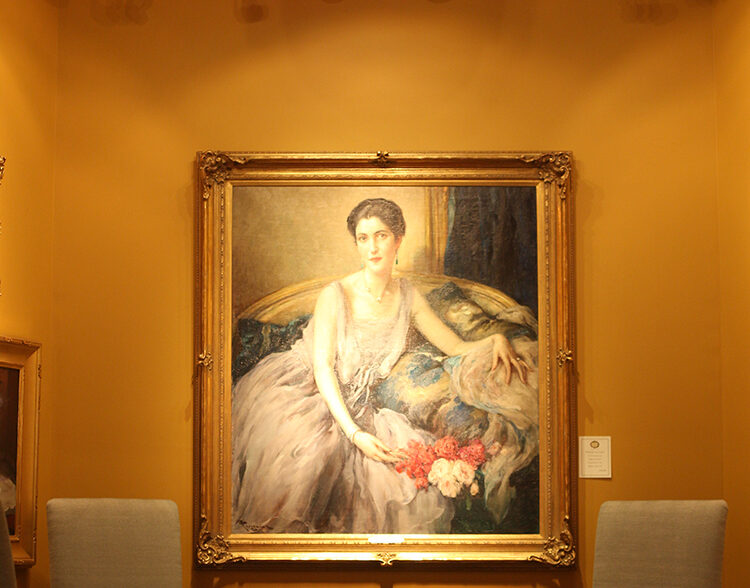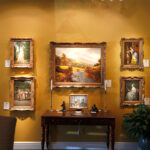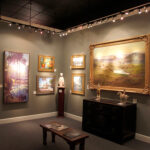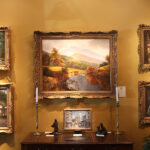
The J.M. Stringer Gallery of Fine Art on Ocean Drive is home to an exceptional collection of artworks, as evidenced by its current exhibit, Masterworks: Then and Now, which opened in mid-March and will remain on display through June.
Many of the artworks are highlighted in the show’s catalog, but gallery co-owners John Stringer and Caesar Mistretta are always happy to provide the history and providence for each piece.
“The ‘Now’ refers to the work of John Phillip Osborne and John C. Traynor, two of our really top, top resumed artists. Dealers of antique paintings all will tell you we’re just kind of walking through time with them. They’re two you can count on that will be highly collected in the future,” says Stringer of the two American artists.
The “Then” features antique works from a variety of collectors, some of whom purchased from the gallery years ago and are now at a point where they may be looking to downsize.
“And we’re happy to see them again. It’s kind of like seeing old friends,” says Stringer. In a way, he adds, the exhibit is akin to the Vero Beach Museum of Art’s Vero Collects: Hidden Treasures exhibit. “Because we have great paintings that were collected by some of our most discerning clients.”
Among them is a rare antique painting by the renowned Russian-French artist Marc Chagall: “L’ange au Violon,” a 15.5-inch by 11-inch gouache.
“It has a great provenance because this was done in 1939. Chagall did this and gave it as a gift to a man by the name of Bruno Walter. He was a composer, violinist and conductor in Germany, and with the rise of Hitler was able to get out and go to France. He [Walter] became a French citizen in 1939, and this was given as a gift to him by Chagall. So, it has a great history,” says Stringer.
On its back, says Stringer, are labels of various dealers, including that of the Kennedy Gallery in New York. “And now it comes to us.”
Another outstanding painting is “Sunrise at the Marsh,” by German-American artist Albert Bierstadt.
“Albert Bierstadt is one of the greats associated with the Hudson School, and he went West and painted all these great paintings of the Rockies and Yosemite,” says Stringer.
“But this is a painting that’s of much more interest to people who live here because it’s a low country painting, and yet you see that beautiful, prismatic palette of the sky and it employs all the techniques that Bierstadt was known for.”
At 47 inches by 41 inches, the majestic “Portrait of a Lady” is one of the show’s larger pieces, painted by the celebrated Belgian artist Fernand Toussaint.
“And we know her name is Yvette because that’s on the back of the canvas. We sold this painting a good 25 years ago, and it’s come back. It’s one of the great masterpieces for Fernand Toussaint,” says Stringer.
In 1929, he says, a famed Parisian art critic wrote that “Toussaint is the undisputed master at capturing the grace and charm of women.”
“And this painting kind of epitomizes that, because you can see the beautiful, fluid motion of her arms, and hands, the way the dress is done is so beautifully – elegance, elegance, elegance. So, it’s a huge find. It’s a major work of art.”
“The New Arrival,” a 24-inch by 30-inch oil painting by Bernard Pothast, is a charming depiction of a mother cradling the newest addition to the family, as her two toddlers look on.
“It’s really just beautifully painted. He was Dutch by birth but for most of his career he lived in Belgium. He was highly respected and collected during his time,” says Stringer.
“Caesar and I have probably sold four others in our whole career, because they’re very rare to find. But none rivaled or came close to this one. This one is really the ultimate.”
On a smaller scale – in size only, not distinction – is “Arabian Market,” a 9.5-inch by 13-inch oil by the famed Italian painter Alberto Pasini.
“This is a wonderful, rare find that came into the gallery. Pasini was an Italian artist, mid-19th century, and the single most sought-after work by Pasini are his Orientalist paintings that he painted from North Africa, Constantinople, everywhere in that region,” Stringer explains.
“And they rarely, rarely surface. This was from local hands, brought here before World War II. This painting, in my opinion, is one of the finest Pasinis to surface in countless years. It is that rare. So, it’s a little jewel for a collector.”
“Figures on a Beach,” a 14-inch by 19-inch oil on panel by Andreas Achenbach, is representative of the German landscape/seascape artist, which often underscore the dangers of a roiling North Sea.
“They either look like Dutch, Flemish or German people sitting on the shore, watching what’s going on out there in the sea. It’s really very, very special.”
Referencing “Cattle in Autumn,” a 28-inch by 36-inch oil by landscape painter Sidney Richard “Percy” Williams, Stringer comments that you’ll often see his works at prominent shows in New York and Europe.
“If they have a Percy Williams, they’re going to bring it and they’re going to show it. He’s really such a blue-chip artist. This one was in private hands here for years. This painting used to be in the Orlando Museum of Fine Art and was purchased over 25 years ago by our client when the museum needed funds,” says Stringer. “This is one of the finest Percy Williams that you’ll ever see. It’s really exquisite.”
A quartet of works of women, each painted with exquisite detail, came from an estate in Vero Beach, where they had been displayed together, as all are of comparable size. The smallest is 16 inches by 12 inches and the largest is 21.5 inches by 14.25 inches.
Two, “Eavesdropping” by Louis Devedeux and “A Stroll Thru the Borghese Garden” by Edouard Ducros, are by French painters. “The Mistress of Vanity” is by American artist Joseph Henry Boston, and “Dans le Jardin” is by Belgian artist Florent Willems.
Of “News from America,” by Royal Academy artist George Henry Boughton, whose historical works are at the Tate Gallery in London, Stringer says, “It’s shocking it’s even here.”
He explains that the painting depicts the days of the Irish potato famine. “As the story goes, you see how hard the women have been toiling, digging, trying to find those potatoes. And this gent is coming up to tell them he’s gotten word that their relatives made it to America safely. It’s a very important work.”
A notable larger work by Osborne is “Donegal Showers,” a 40-inch by 50-inch oil on linen, which softly reflects what Osborne describes as his “lifelong study of the infinite effects of light that nature has to offer.”
Osborne is also known for paintings based on the American Revolution, such as, “Reading of the Declaration of Independence,” an 8-inch by 12-inch oil on panel.
Referencing Traynor, Stringer says, “Here you have one of John’s masterful still-lifes called ‘Sunflowers in Red Porcelain,’ a 40-inch by 30-inch oil on linen. I think the sunflowers are so beautiful, and because of what’s going on in Ukraine, it’s very special.”
In addition to its remarkable collection of paintings, the gallery houses furniture, sculpture and antiquities, including a remarkable Greek Attic Red-Figure Bell Krater.
“You’d have to go to the Metropolitan Museum, or the British Museum or maybe to Athens to find something as fine as this. It’s from 370 BC, and it would have been used for wine. Really, it’s such a rare, rare thing, and the condition is extraordinary,” says Stringer, noting that it came from “one of America’s leading dealers of antiquity for countless years.”
For more information, visit jmstringergallery.com or call 772-231-3900.
Photos by Kaila Jones








